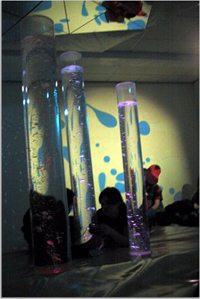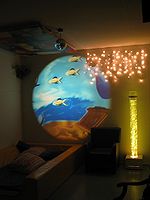
Snoezelen
Encyclopedia


The defining principles of the MSE help the practitioner to focus attention on the basic elements of this approach. The following are the principles.
The principles
1. The experience takes place in a specific physical environment.
2. The attitude of the practitioners is "client centered".
3. Stimuli must be controlled according to the client's needs.
4. The MSE is a media for communication.
5. The sensory environment is neither positive nor negative.
6. The practitioner relies on the client's point of view. (Shapiro, 2010).
It is used for people with developmental disabilities , and involves exposing them to a soothing and stimulating environment, the "snoezelen room". These rooms are specially designed to deliver stimuli to various senses, using lighting effects, color, sounds, music, scents, etc. The combination of different materials on a wall may be explored using tactile senses, and the floor may be adjusted to stimulate the sense of balance.
Originally developed in the Netherlands
Netherlands
The Netherlands is a constituent country of the Kingdom of the Netherlands, located mainly in North-West Europe and with several islands in the Caribbean. Mainland Netherlands borders the North Sea to the north and west, Belgium to the south, and Germany to the east, and shares maritime borders...
in the 1970s, Snoezelen rooms have been established in institutions all over the world and are especially common in Germany
Germany
Germany , officially the Federal Republic of Germany , is a federal parliamentary republic in Europe. The country consists of 16 states while the capital and largest city is Berlin. Germany covers an area of 357,021 km2 and has a largely temperate seasonal climate...
, where more than 1200 exist.
The term "snoezelen" /) is a neologism formed from the Dutch
Dutch language
Dutch is a West Germanic language and the native language of the majority of the population of the Netherlands, Belgium, and Suriname, the three member states of the Dutch Language Union. Most speakers live in the European Union, where it is a first language for about 23 million and a second...
"snuffelen" (to seek out, to explore) and "doezelen" (to doze, to snooze).
Ideally, Snoezelen is a non-directive therapy and can be staged to provide a multi-sensory experience or single sensory focus, simply by adapting the lighting, atmosphere, sounds, and textures to the specific needs of the client at the time of use. There is no formal focus on therapeutic outcome - the focus is to assist users to gain the maximum pleasure from the activity in which they and the enabler are involved. An advantage of snoezelen is that it does not rely on verbal communication and may be beneficial for people with profound autism, as it may provide stimulation for those who would otherwise be almost impossible to reach.
Snoezelen is used for people with autism
Autism
Autism is a disorder of neural development characterized by impaired social interaction and communication, and by restricted and repetitive behavior. These signs all begin before a child is three years old. Autism affects information processing in the brain by altering how nerve cells and their...
and other developmental disabilities
Developmental disability
Developmental disability is a term used in the United States and Canada to describe lifelong disabilities attributable to mental or physical impairments, manifested prior to age 18. It is not synonymous with "developmental delay" which is often a consequence of a temporary illness or trauma during...
, dementia
Dementia
Dementia is a serious loss of cognitive ability in a previously unimpaired person, beyond what might be expected from normal aging...
, brain injury
Acquired brain injury
An acquired brain injury is brain damage caused by events after birth, rather than as part of a genetic or congenital disorder such as fetal alcohol syndrome, perinatal illness or perinatal hypoxia. ABI can result in cognitive, physical, emotional, or behavioural impairments that lead to permanent...
and even toddlers. However, research on the benefits of treatment is scarce, based on variable clinical study designs.
A small research study carried out in Brussels compared the behavior of nine adult clients with profound autism in both classroom and Snoezelen settings. Though individual results varied, the study claimed a 50% reduction in distress and stereotypical behavior, and seventy-five percent less aggression and self-injury in the Snoezelen environment.
External links
- International Snoezelen Association, with definition of snoezelen, bibliography, meetings etc.
- Report on the use of a snoezelen room at Jackson Memorial HospitalJackson Memorial HospitalJackson Memorial Hospital is a non-profit, tertiary care teaching hospital and the major teaching hospital of the University of Miami Leonard M. Miller School of Medicine in Miami, Florida...
, fall 2004 - Photo galleries of various snoezelen rooms
- Italian section of the Snoezelen Foundation presentation of various snoezelen rooms and home care applications through telematics links
- Snoezelen in Israel

